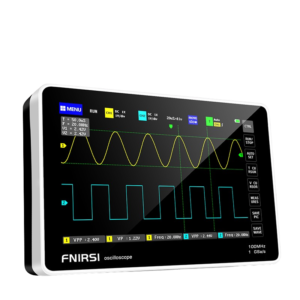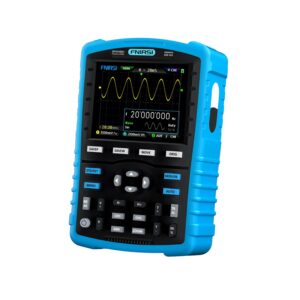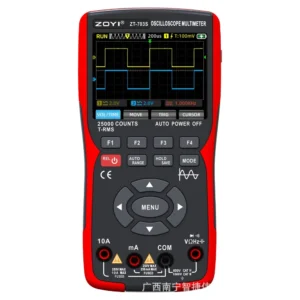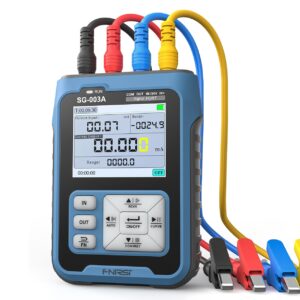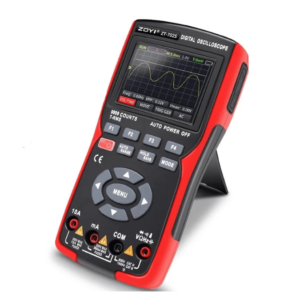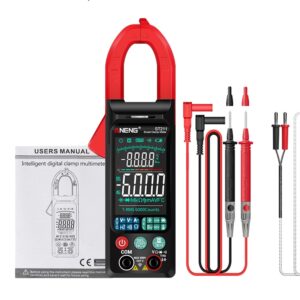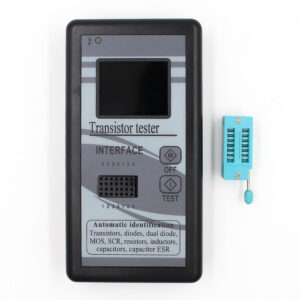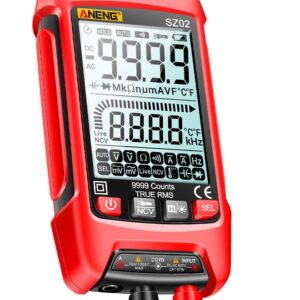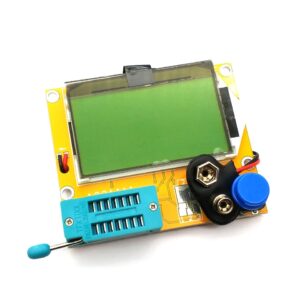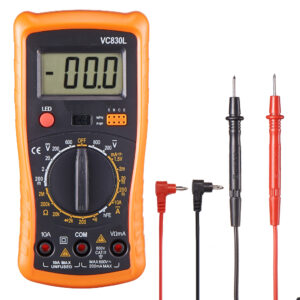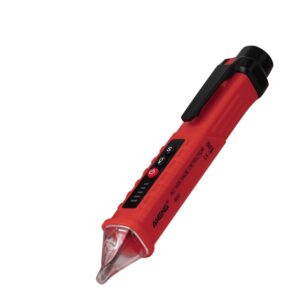Electronic Testing Equipment
Quality Test Equipment and Meters for Electrical Testing and Measurement
Welcome to our Electronic Test Equipment (ETE) category. Here, you will find a comprehensive range of tools and devices designed to measure, test, and diagnose the functionality of electronic devices and systems.
Explore our soldering irons, lithium polymer batteries, fnirsi oscilloscope and servo motor drivers.
Showing all 12 results
Showing all 12 results
What Is Electronic Testing Equipment?
Electronic testing equipment encompasses a wide range of instruments used to test, measure, and diagnose electrical circuits and components by evaluating parameters such as voltage, current, and resistance, which are essential for ensuring the proper functionality and safety of electronic systems.
Types of Electronic Testing Equipment
There are various types of electronic testing equipment, each designed for specific measurement and diagnostic tasks, including:
- oscilloscopes
- frequency counters
- multimeters and clamp meters
- logic analyzers
- signal generators
- spectrum analyzers
- LCR meters
- power supplies
Oscilloscopes
Oscilloscopes are essential instruments for visualising electrical signals, allowing engineers to observe waveform types, voltage levels, and frequency characteristics of electronic circuits.
One of the key features of oscilloscopes is their ability to display waveforms graphically, providing a visual representation of how a signal changes over time. This visualisation is crucial for troubleshooting and debugging electronic systems as it helps in identifying anomalies or irregularities in the signal.
Oscilloscopes can accurately measure voltage levels with precision, enabling engineers to ensure that the signal meets specific requirements and standards. These instruments are equipped with various tools for analyzing frequency characteristics, allowing users to detect signal distortions, harmonics, and other critical parameters.
Multimeters
Multimeters are versatile instruments that measure multiple electrical properties such as voltage, current, and resistance, and can also function as continuity testers for checking the integrity of circuits.
These handy devices come in different types, from analogue to digital, offering various features for accurate readings. With a multimeter, you can quickly determine the voltage across components, measure the current flowing through a circuit, and assess the resistance encountered. Their utility extends to testing the continuity of wires and connections, ensuring proper electrical flow. Whether you are a professional electrician or a DIY enthusiast, a multimeter is an critical tool for diagnosing and troubleshooting electrical systems.
Logic Analyzers
Logic analysers are specialised tools used to capture and analyse digital signals, enabling engineers to perform timing and state analysis on complex digital circuits.
By connecting to the digital circuit being tested, a logic analyser can capture a wide range of digital signals, displaying them in a graphical format for easy interpretation. Engineers can then delve into the timing relationships between different signals and analyse the sequence of events within the circuit.
This detailed analysis helps in debugging and optimising the performance of digital systems, ensuring they function as intended. With advanced features such as protocol decoding and triggering capabilities, logic analysers are critical tools for electronic design and troubleshooting.
Signal Generators
Signal generators, including function generators, are used to produce electrical signals with various waveform types, frequencies, and amplitudes, crucial for testing and troubleshooting electronic circuits.
These versatile devices are essential in a range of applications, from designing and testing electronic equipment to calibrating devices and simulating real-world signals.
Signal generators can generate different types of waveforms such as sine, square, triangle, sawtooth, and pulse waves, allowing engineers to mimic various signal conditions.
The ability to adjust the frequency and amplitude of the generated signals enables precise control over the output, making them invaluable tools in signal processing and communications.
Spectrum Analysers
Spectrum analysers are used to measure the frequency spectrum of electrical signals, providing critical insights into signal analysis and the behavior of RF signals.
These instruments are essential tools for engineers and technicians working in various industries such as telecommunications, aerospace, and electronics.
- By capturing and displaying the frequency domain characteristics of signals, spectrum analyzers enable users to identify signal interference, analyse modulation techniques, and troubleshoot communication issues.
- With their ability to detect and measure signal strength, bandwidth, and distortion, these devices play a crucial role in optimising signal performance and ensuring the quality of RF communication systems.
Network Analyzers
Network analysers are essential for evaluating the impedance and S-parameters of RF components, providing detailed analysis of how these components behave under various conditions.
These sophisticated instruments play a crucial role in the testing and optimisation of RF systems, ensuring that components meet performance specifications.
By accurately measuring impedance, network analysers help engineers identify mismatches in the system, allowing for adjustments to be made for improved signal transmission.
The S-parameters obtained through network analysis offer insights into the behaviour of complex RF networks, aiding in the design and troubleshooting process.
Power Supplies
Power supplies provide the necessary voltage and current to power devices under test (DUTs), ensuring consistent and accurate testing conditions.
This essential electronic equipment plays a vital role in maintaining a stable electrical environment for testing sensitive electronic components. By delivering precise voltage levels and controlled current flow, power supplies enable engineers to analyse the performance and behaviour of DUTs with accuracy and reliability.
It is crucial to select the appropriate power supply to match the requirements of the specific testing applications, considering factors such as voltage range, current capacity, and adjustable settings to meet varying DUT specifications.
Function Generators
Function generators are versatile tools that create various waveform types at different frequencies, aiding in signal generation for testing electronic circuits.
These devices can generate standard waveforms like sine, square, triangle, and sawtooth waves with precise control over frequencies ranging from a few hertz to several megahertz.
Function generators offer adjustable voltage levels and duty cycles, allowing users to simulate diverse signal conditions accurately.
Frequency Counters
Frequency counters measure the frequency of electrical signals with high accuracy, making them critical for applications that require precise signal frequency measurements.
These devices work by counting the number of signal cycles within a specific time period and displaying the result in Hertz (Hz).
By accurately determining the frequency of signals, frequency counters play a crucial role in various fields, including telecommunications, scientific research, and electronic testing.
They are utilised to ensure the proper functioning of electronic systems and equipment, aiding in troubleshooting and optimising performance.
LCR Meters
LCR meters are specialised instruments used to measure the inductance, capacitance, and resistance of electronic components, providing essential data for component analysis and circuit design.
Inductance, measured in henries, refers to the ability of a component to store energy in a magnetic field when a current passes through it.
Capacitance, measured in farads, defines the component’s ability to store electrical energy in an electric field.
Resistance is measured in ohms and determines how much a component impedes the flow of current.
These measurements are crucial in ensuring proper functionality and efficiency in electronic systems.
Uses of Electronic Testing Equipment
Electronic testing equipment is utilised across various applications, including:
- faultfinding and diagnostics
- quality control and inspection
- research and development
- calibration and testing
ensuring accurate and reliable performance of devices under test (DUTs) and automated test equipment (ATE).
Troubleshooting and Diagnostics
Troubleshooting and diagnostics involve using electronic test equipment to identify and locate faults within electronic circuits, ensuring efficient fault detection and resolution.
Electronic test equipment plays a crucial role in modern technology by enabling technicians to pinpoint issues accurately. By utilising specialised tools such as multimeters, oscilloscopes, and logic analysers, professionals can delve deep into the circuitry to detect anomalies. The precision offered by these instruments is essential for timely and successful resolution of faults, preventing potential system failure and reducing downtime. With accurate fault detection, repairs can be carried out swiftly, minimising disruptions and ensuring the optimal performance of electronic devices.
Quality Control and Inspection
Quality control and inspection processes rely on precise measurement and calibration of electronic test equipment to ensure that products meet specified standards and minimise test errors.
Electronic test equipment plays a crucial role in identifying deviations and ensuring the consistency and reliability of products during production. By using advanced measurement tools and accurate calibration techniques, test errors can be significantly reduced, resulting in improved product quality and customer satisfaction. These instruments help in maintaining compliance with industry regulations and standards, creating a streamlined and efficient inspection process. Calibration of equipment is vital to ensure that measurements are accurate and reliable, allowing companies to make informed decisions based on precise data.
Research and Development
In research and development, electronic test equipment plays a critical role in data acquisition and real-time control, aiding in the innovation and enhancement of electronic technologies.
Electronic test equipment provides engineers and scientists with the necessary tools to measure and analyse electrical signals accurately, ensuring the quality and performance of electronic devices.
Through data acquisition, researchers can collect precise information and make informed decisions to improve their products.
The real-time control capabilities of these instruments enable immediate adjustments and optimisations during testing processes, contributing to efficient and reliable results.
This integration of technology and testing procedures is fundamental for the advancement of various industries and the development of cutting-edge electronics.
Calibration and Testing
Calibration and testing ensure that electronic test equipment maintains accuracy and reliability, often involving the use of calibration tickboxes to verify performance standards.
Calibration is an essential process in the field of electronics that involves comparing the readings of a piece of equipment to a known standard to ensure the measurements are accurate.
Regular testing and calibration help in identifying any deviations, tweaking the equipment to meet specified standards, and guaranteeing the authenticity of the results obtained.
By meticulously following the calibration tickboxes, technicians can affirm the optimal functioning and precision of electronic test equipment, thereby establishing confidence in the test outcomes.
How to Choose the Right Electronic Testing Equipment?
Selecting the right electronic testing equipment involves:
- Determining your specific testing needs
- Considering your budget
- Checking for compatibility with existing systems
- Reading reviews to compare different brands
Determine Your Testing Needs
To determine your testing needs, identify the specific measurements and applications required for your electronic test equipment, ensuring it meets the demands of your projects.
Begin by assessing the type of signals you need to measure, such as voltage, current, frequency, or digital signals. Consider the range and accuracy required for these measurements to ensure the equipment’s compatibility with your project specifications. Additionally, evaluate the different applications in which you will be using the equipment. This could include testing circuits, debugging electronic components, or analysing waveform characteristics.
Consider Your Budget
When choosing electronic test equipment, consider your budget to ensure you make a cost-effective investment that provides the necessary features without exceeding financial constraints.
It is essential to strike a balance between the features required for your specific testing needs and the overall cost of the equipment. A well-thought-out budget helps you avoid overspending on extravagant features that may not be necessary for your applications. Cost-effective choices can still offer high-quality performance and durability, ensuring that your investment pays off in the long run.
Check for Compatibility
Check for compatibility between your new electronic test equipment and existing systems to ensure seamless integration and optimal performance.
Ensuring compatibility between your newly acquired electronic test equipment and the systems in place is crucial for a smooth integration process. It is essential to verify that the specifications and interfaces of the new equipment align with those of your existing systems to prevent any potential conflicts or performance issues.
By conducting thorough compatibility checks, you can minimise the risk of downtime and errors that may arise from incompatible hardware or software. This seamless integration not only enhances the overall efficiency of your testing processes but also helps in maximising the value of your investment.

